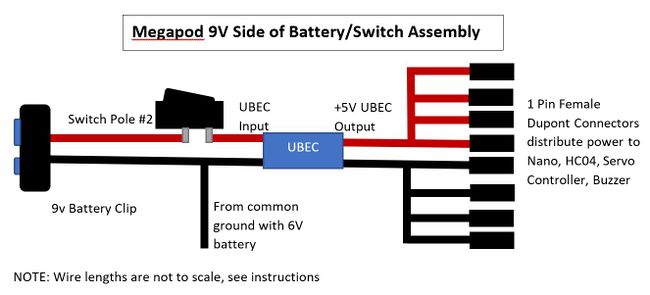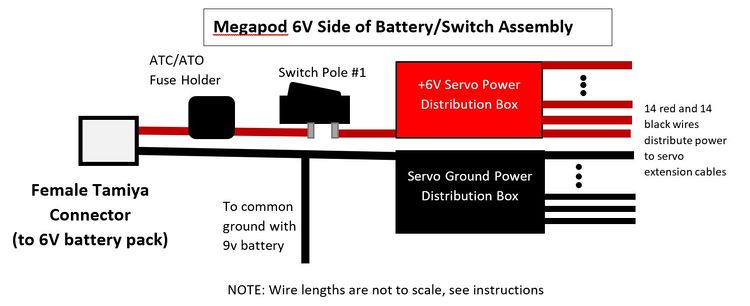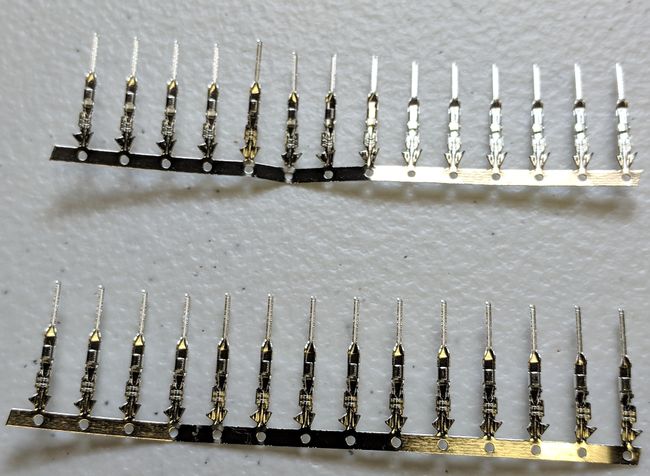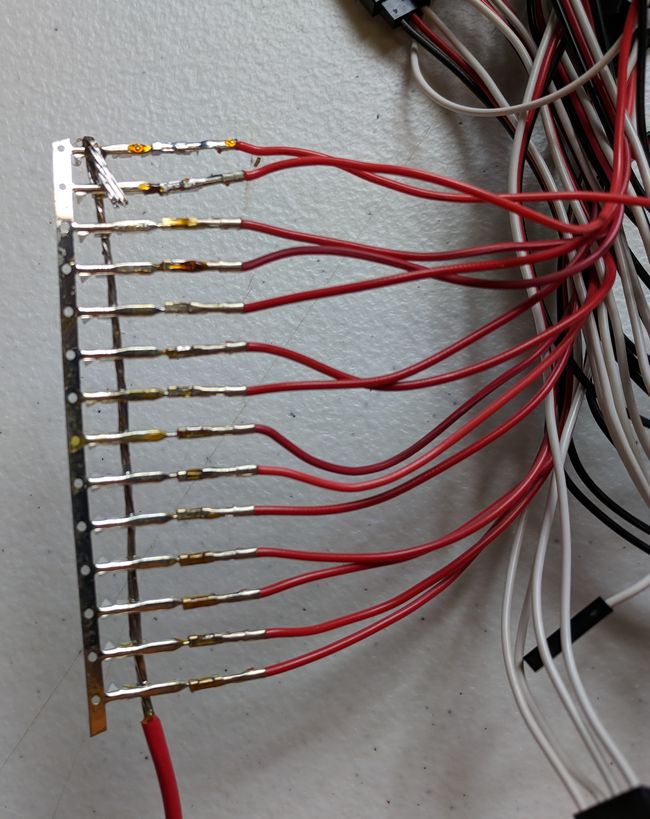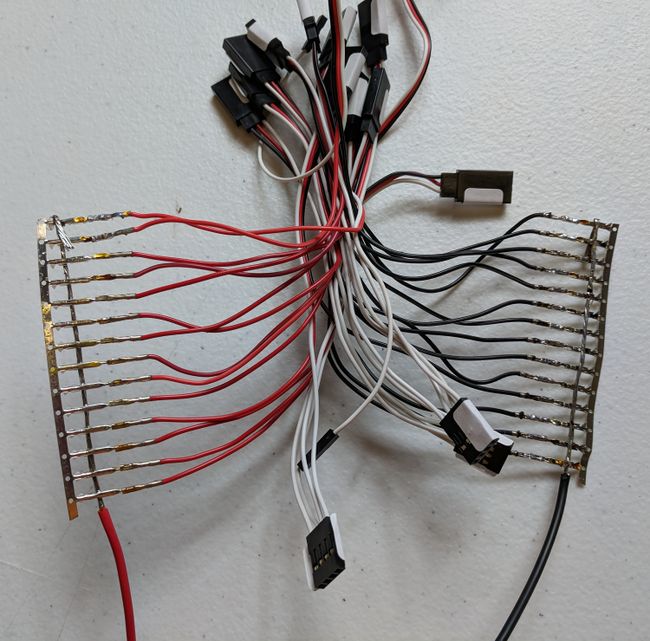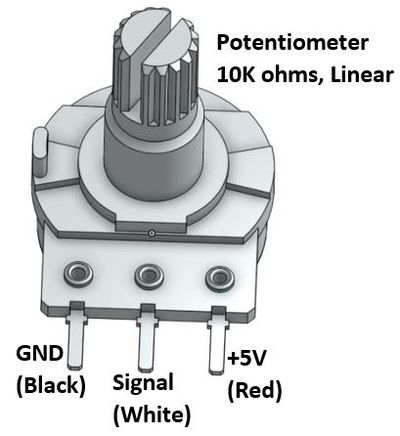Max The Megapod Battery/Switch Construction
This page is not yet complete. Do not attempt to use it yet to build Max the Megapod.

Contents
Self sourcing parts
If you purchase kit parts from Vorpal Robotics, you will receive the battery/switch assemblies for both the hexapod and gamepad pre-assembled with no soldering required. These instructions are for people who wish to source their own parts. These instructions assume you are familiar with soldering, stripping wires, and other basic electrical tasks. There is just enough detail here for people who are experienced in building circuits to make the parts. It's beyond the scope of these instructions to teach the basics of electronics.
Vorpal Store
If you want to source most of your own parts but can't find an item or two, we have every part individually available at the Vorpal Robotics Store.
If you source your own parts and feel the project has been worthwhile, we would respectfully ask you to make a $3 donation at our store. This will help us continue to develop great new projects. Go here to make a donation: Vorpal Store Donation
A Note On Support for Self-Sourcers
We are happy for Makers to source their own parts, that's why we made this project Open Source. However please do not ask us for a ton of support to help get your project to work if you're doing that! If you want to self-source parts, you need to be familiar with things like soldering, electronics terminology, configuring Bluetooth modules, flashing Arduino programs, etc. If you don't have those skills, our kits are a much better way to go; or try some easier projects first to learn those basic Maker skills before tackling this one.
Our first priority for support has to be our paying customers, that's what allows us to continue working on new great open source projects. We're glad to help on a time-available basis, and it's perfectly fine for you to post questions to our Vorpal Robotics Forum to ask the Vorpal community for help.
Gamepad Battery/Switch Assembly
You will need:
- A standard 9v battery clip with RED/BLACK color coded lead wires.
- A rocker switch, single throw single pole. The hole for the switch in the 3D models is 10mm x 14mm to accommodate a switch with hole profile 9mm x 13mm. If you can't get that exact size you either have to keep the switch inside the robot and remove the cap to use it, or you would need to modify the 3D models.
- Two single pin Dupont female connectors, preferably one RED and one BLACK wire so you can color code the power properly.
- Some shrink tube or electrical tape to insulate connections.
- Tools and supplies: wire stripper, soldering iron, solder, heat gun or other means to shrink the shrink tube.
The diagram below shows how connections are made. As usual, RED colored wires will be connected to positive voltage, while BLACK wires are for ground.
Wire lengths are not to scale. You need the wires with the Dupont connectors to be at least 4 inches (100mm) long, and you need about the same from the switch to the 9v battery clip.
Hexapod Battery/Switch Assembly
This power harness feeds power to the servos, the servo controller, the Arduino Nano, the HC05 Bluetooth module, and the buzzer. There are two different voltages used in the robot: a 6v NIMH battery for motors and 9v transistor battery for logic circuits. The 9v battery will be regulated down to 5v for the logic circuits. A double pole ON/OFF switch is used to turn both batteries on and off at the same time.
Unlike the smaller Vorpal Hexapod, the servo controller is not used to feed power to the servos--it only provides the signal line. Servo extension cables are rigged up in this harness so that the red and black wires (positive and negative sides of the battery) are split off from the white wire (signal) and connected to the battery through a fuse and the on/off switch.
You will need:
- A female Tamiya connector (full sized, not mini-Tamiya) which will be used to plug in the battery pack. If you have a battery pack with some other connector such as XT60 or T connector, feel free to substitute.
- A 9v battery clip.
- A rocker switch, single throw double pole (STDP). The hole for the switch in the 3D models is 22mm x 29mm. If you can't get something that size you either have to keep the switch inside the robot and remove the cap to use it, or you would need to modify the 3D models. One pole of the switch will control the servo battery connected to the Tamiya connector, the other pole will control the 9v battery used to power logic circuits.
- Two single pin Dupont female connectors, preferably one RED and one BLACK wire so you can color code the power properly. These will feed power to logic circuits.
- Twelve servo extension cables at least 15mm long (male one one side and female on the other) to be used for power distribution to the 12 servos. Optionally you can have two more to power future accessories but twelve is the minimum. You can add the two extras later if desired. The extras are probably better if they're a little longer, 20cm or 30cm.
- A UBEC (BEC) to provide 5V regulated power to the logic circuits, it should be able to provide 3A to ensure it can handle future extensions.
- IMPORTANT NOTE: Makers who sourced their own parts have reported that the following UBECs do not work for this project. Although they claim to be able to output 3A or higher, apparently they shut down during brief surges:
- FPV Bluesky BEC
- 5V/4A RC Model Airplane Helicopter Speed Control 4A UBEC Brushless ESC IB (sourced on Ebay)
- IMPORTANT NOTE: Makers who sourced their own parts have reported that the following UBECs do not work for this project. Although they claim to be able to output 3A or higher, apparently they shut down during brief surges:
- Some shrink tube or electrical tape to insulate connections.
- A roll of male Dupont terminal pins, all connected together. You'll need two strips that are 14 pins each. These are going to be used to distribute power to the servos.
- 18 gauge wire in both red and black colors, you'll only need about a foot of each.
- Tools and supplies: wire stripper, soldering iron, solder, heat gun or other means to shrink the shrink tube.
The diagrams below shows how connections are made. As usual, RED colored wires will be connected to positive voltage, while BLACK wires are for ground.
9V Side of the Harness
You can think of the harness as being in two pieces, the 9v battery side and the 6v battery side. These sides are hooked together on the positive side (RED) by the SPDT switch. Each side gets one of the two poles of the switch. The diagrams below each show a switch, but it is the same switch, just different poles.
Be very sure that you know which side of the UBEC is input from the battery, and which side is 5V regulated output. The UBEC we use has a 3 pin Dupont connector on the output side, although only 2 pins are populated (+5V, RED wire, and Ground, BLACK wire). This connector will be cut off and replaced by multiple red and black Dupont wires to feed power to each logic module (nano, servo controller, Bluetooth module, buzzer).
Wires are not shown to scale. Here are the minimum lengths you need:
- Red and black dupont connector wires on the right of the diagram should be 15cm long or longer.
- The wire going from the red and black output side of the BEC to the bundles of Dupont red/black wires should be at least 15cm long.
- There should be at least 30cm of wire between the 9V clip and the switch, and the black side of the 9V clip should be similarly sized.
- The wire that will be used to bridge the common grounds between 9v and 6v side of the circuit should be at least 15cm long.
6V Side of the Harness
Potentiometer Wiring
You will need:
- A 10k ohm, linear rotary potentiometer with 6mm shaft.
- Three jumper wires, 150mm long, with a female Dupont connector on one end.
- Suggested colors are: 1 red, 1 black, 1 white (or any other color besides red or black for signal).
- You can purchase two-end jumpers and just cut off one end.
- You could also use a servo extension wire with the male end cut off.
- Some shrink tube or electrical tape to insulate connections.
- Tools and supplies: wire stripper, soldering iron, solder, heat gun or other means to shrink the shrink tube.
See the diagram at the right. Solder the wires in the order shown, and use either tape or shrink tube to insulate the solder joints.
A Note on HC05 Connections
The kits we sell use HC05 modules that are 5v tolerant. The model number on the module included in our kits is E475833. The manufacturer's own documentation shows this module being used directly with a 5V Uno digital IO pin. For this reason, we do not require a voltage divider when hooking the Rx pin of the HC05 to an Arduino Nano digital IO pin.
However, if you are using modules that are not 5v tolerant, you will need a voltage divider. There are tutorials all over the internet describing how to do this, and if you are sourcing your own parts you may need to use that information to protect the modules you use.
Vorpal The Hexapod Quick Links
| Sign Up For Our NEWSLETTER | VORPAL FORUM: Join the Discussion | |||
|
User Documentation: |
Getting & Giving Vorpal |
Activities: |
Contact/Press: |
|

